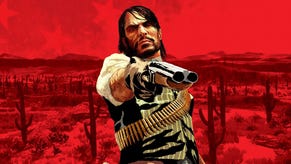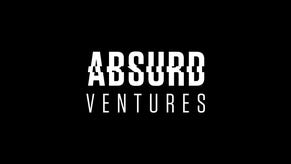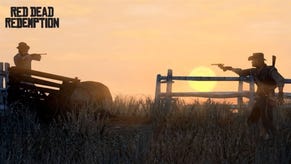Red Dead Redemption on Switch: an impressive, creditable port
Better than Xbox 360, comparable to PS4.
The release of Red Dead Redemption on PlayStation 4 and Nintendo Switch opens the gates for more people to enjoy Rockstar's wild west classic and the good news is that the Switch version is an excellent fit for the hardware. Expectations were higher for the PS4 version, but the bottom line is that aside from some more minor disappointments, what you're getting here is essentially a game that looks and plays like the Xbox 360 720p original in handheld mode, which rises to a native 1080p mode when docked.
First the basics. Ported by Double Eleven Studios with support from Rebellion North, this release has content parity with the PS4 version. The 11.4GB install crams in the main Red Dead Redemption adventure, plus the Undead Nightmare expansion - though sadly, the multiplayer mode of the original release is chopped out here. The 1080p docked presentation is the highlight though. In direct comparison with the Xbox 360 and PS3 originals, Red Dead's huge landscapes benefit from a huge boost in clarity on Switch. Distant detail is more defined, and the higher pixel count in general reduces the flickering artefacts - the noise - on fine details like fences.
Immediately then we're off to a good start with the Switch release. In fact, at 1080p we're in essence matching the base PS4 version's native resolution already. But native resolution isn't the only factor for image quality. After all, anti-aliasing type plays a big role in tidying up the shimmering, the noise, and other visual artefacts too. Sadly - but perhaps inevitably - the Switch game uses FXAA post-process anti-aliasing, whereas the PS4 version can tap into temporal super-sampling via AMD's FSR2. In truth, FXAA doesn't look quite as good as the 2x MSAA found in the Xbox 360 original, but the burden on the GPU will be much lower.
As you might imagine though, other visual enhancements over the original Xbox 360 code are limited. LOD settings for geometry and plants are identical - meaning buildings pop in at the exact same range as on 360. And beyond this, even the core texture work is identical to that 2010 release, right down to character faces in close-up. This isn't unexpected given the turnout on PS4, but deploying more modern features could have elevated the presentation. Even adding ambient occlusion under grass would have gone a long way to give the scene some depth.
In its defense, just like the PS4 version, there is a boost to shadow quality across the game, resulting in harder shadow outlines under the midday sun - and you might notice a slight change to the presentation of SSR on the water during its opening cut-scene. Otherwise, this Switch effort really is the same game, the main bonus being its 1080p boost while docked, and of course the ability to play it as a portable.
The only real drawback on Switch, to my eyes, is the low texture filtering quality across the ground, which doesn't even compare well to the Xbox 360 rendition of the game. Despite the texture assets being a match on Switch, their presentation at tight angles - the kind of angle you'd typically view the ground at while running - is often blurred.
So, is the Switch build a match for PS4 in visual settings, beyond the anti-aliasing limitation? In comparison, the texture filtering limit on Nintendo's machine shows up visibly. PS4 pushes for much a higher anisotropic filtering setting, and so again, expect the presentation of ground textures, at an angle, to be cleaner on Sony's machine. Beyond that, foliage density is identical between the two, though there's a slight improvement to tree draw distances on PS4 on occasion. Generally though, pop-in across geometric elements - the rocky outcrops - are an exact match with PS4's.
In the main Switch offers a vert solid, and very comparable return next to PS4, then - all of which brings us to performance. There are no surprises here. It's 30 frames per second on Switch and to be honest, bearing in mind it's running at 1080p with all these settings, it's more defensible to see 30fps here than on PS4. The Tegra X1 chipset at its core isn't in the same league spec-wise as Sony's home console, and yet we're still getting an impressive 1080p30 return.
A huge bulk of play runs at this 30fps line, too, though there are some notably exceptions. Firstly, just arriving at the Armadillo saloon at night drags the performance to below 30fps. And more noticeably, I spotted a farm battle on Switch drop into the high-20s. High levels of NPCs congested in one spot appears to be the recurring culprit here. There's also a very occasional sign of uneven frame-pacing at 30fps, prompting frame-time spikes to 16ms. It's not perfect, but it's mostly stable.
Overall, the turnout in performance is a success. Even the Undead Nightmare expansion - a much more taxing zombie twist on Rockstar's world - runs mostly at 30fps. And for perspective, this is a huge upgrade on the original Xbox 360 version. Looking at some older analysis footage from our archives, the 360 version struggled with an early graveyard mission. On original 360 hardware this sequence dropped close to the 20fps line with tearing, while a One S running the 360 code at least cleaned the performance up.
On Switch, this graveyard area is an absolutely rock solid 30fps, despite the many zombies and effects on screen. And all round, these extreme cases shows the 1080p target is a sensible, very achievable one. As for portable play, Switch again holds out perfectly at 720p and 30fps. Again the only exceptional point is that farmyard battle with many bandits on-screen, pulling us into the high 20s, but that's still a creditable turnout overall.
There's a final question on frame-rates: should Red Dead Redemption have targeted 60 frames per second on PS4 and perhaps even Switch? Bearing in mind its age - a 13 year old game - seeing 30fps even on top-end hardware like PS5 is obviously a disappointment. Getting 60fps on Nintendo's handheld would have been a bigger challenge - but it's currently possible to see how it might have panned out, thanks to a mod from MasaGrator. In the video, there's a small slice of footage taken directly from an exploited Switch, with the game's frame-rate unlocked.
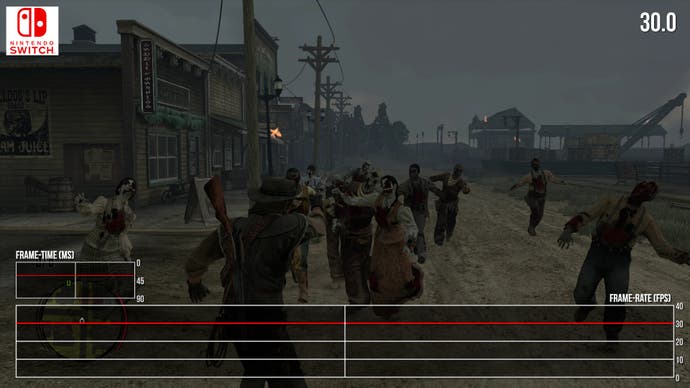
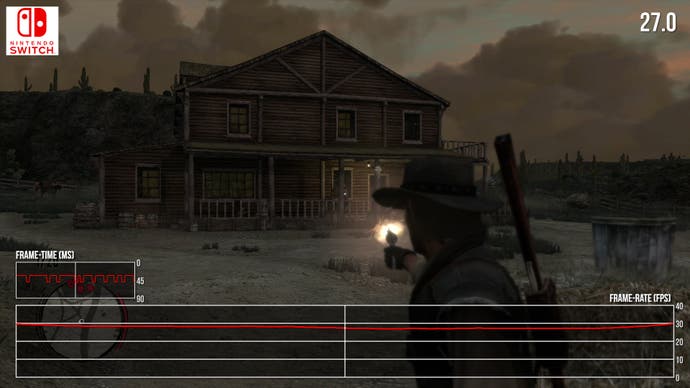

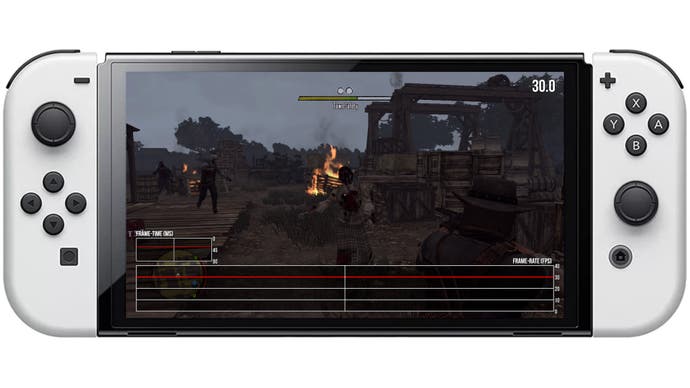
There are a few caveats here. Firstly it's running in portable mode at a native 720p, so 1080p is off the cards. And secondly, to help it hit 60fps, the console's GPU clocks are boosted via a mod, doubling the default 307MHz in portable mode, up to 614MHz. Meanwhile the CPU jumps from the stock 1020Mhz to 1785Mhz, while memory jumps from 1333MHz stock up to 1996MHz. A huge increase! In this configuration, 50-60fps seems possible, but the hardware has been pushed beyond stock clocks every way - bar the GPU, which is clocked lower than the docked configuration's 768MHz. It's a stretch for Nintendo's console hybrid, but you have to wonder if the PS4 version could have delivered more.
In the end, the Switch release only highlights how much more ambitious the PS4 version should have been. Given the lower power spec of Nintendo's console, the release of Red Dead Redemption on Switch is, relatively speaking, much more of a success. Its 1080p30 experience is close to the base PS4 experience - barring the missing FSR2 option, plus the dropped shadow and texture filtering quality. Textures, draw distances are all intact. Equally, it offers the game in portable form. In that respect, the Switch versionmanages to meet expectations, where you'd have hoped for more on PS4 and PS5 systems.
It's by no means a luxury treatment though: a game of this high esteem does deserve more. Improved textures, an upgraded HUD, and even perhaps 60fps support on higher-end consoles. Especially for the high asking price, what we're getting here is surprisingly stripped to only the essentials. But if you've yet to play the game or if you want to experience Rockstar's western classic on the move, it's undeniable that the Switch version gets the job done, albeit at a relatively hefty price-point.






